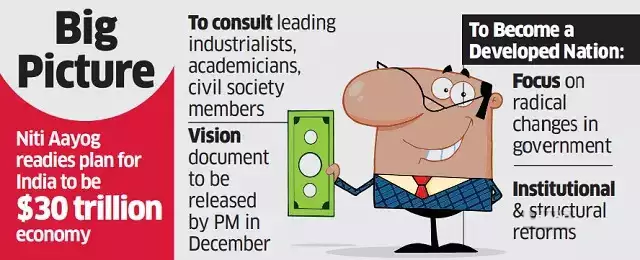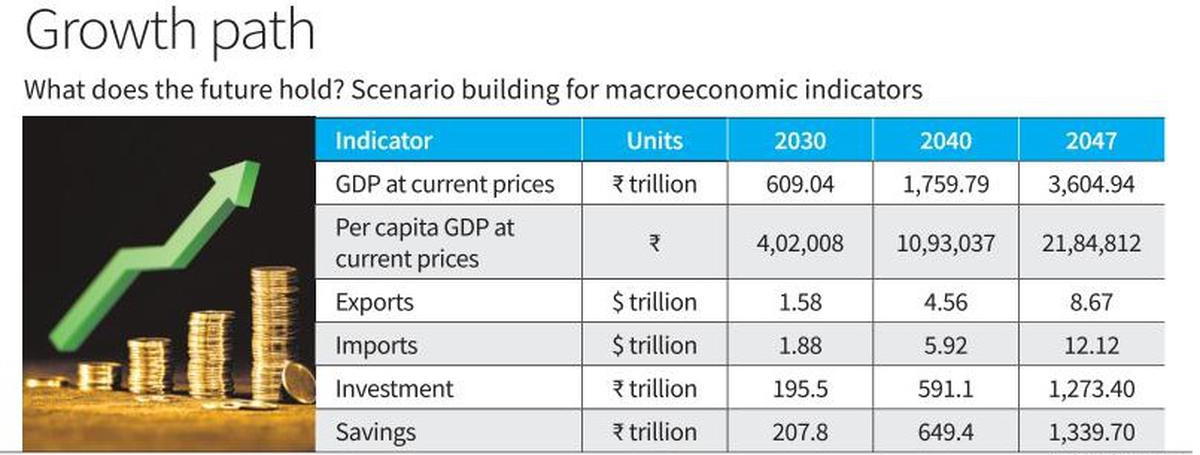Vision India@2047: Transforming the Nation's Future
This editorial is based on “Virtues of planning: On the Vision India@2047 plan” which was published in The Hindu on 02/11/2023. It discusses the government’s blueprint to develop India by 2047, which is expected to be unveiled by the Prime Minister in early 2024.
For Prelims: Vision India@2047, NITI Aayog, PPP (Purchasing Power Parity), Nominal GDP, Demographic dividend, Middle Income Trap, Periodic Labour Force Survey (PLFS), Labor force participation rate (LFPR), Production-linked incentive scheme, National infrastructure pipeline
For Mains: Vision India@2047, Factors that may Contribute to India’s Economic Growth, Challenges before India’s 30 tn Dollar Economy Vision and Way Forward
In early 2024, the Prime Minister is expected to unveil a road map to transform the country into a developed nation with a USD 30 trillion economy by the time it completes 100 years of Independence.
The Vision India@2047 plan, as it is officially named, has been in the works for nearly two years with officials across ministries brainstorming on how to take the country from its current level of development to where it aspires to be.
The NITI Aayog, in the process of giving this vision document a final shape, will soon run its central ideas and goals past top minds across sectors, including World Bank President Ajay Banga, Apple chief Tim Cook, as well as Indian industrialists and thought leaders, to finetune them and factor in any blind spots. Coming ahead of the Lok Sabha election, the plan may well be viewed as the government’s policy playbook promise for prospective voters.
What is Vision India@2047?
- The Project:
- Vision India@2047 is a project initiated by the NITI Aayog, the apex policy think tank of India, to create a blueprint for India’s development in the next 25 years.
- The project aims to make India a global leader in innovation and technology, a model of human development and social welfare, and a champion of environmental sustainability.
- Objectives:
- Achieving a USD 30 trillion economy with a per-capita income of USD 18,000-20,000 and strong public finances and a robust financial sector.
- Building world-class infrastructure and facilities in both rural and urban areas.
- Eliminating unnecessary interference by the government in the lives of citizens and promoting digital economy and governance.
- Developing 3-4 global champions in every sector by merger or restructuring and boosting indigenous industry and innovation.
- Becoming self-reliant in defence and space sectors and enhancing India’s role in the world.
- Fostering green growth and climate action by increasing renewable energy capacity and reducing carbon emissions.
- Empowering the youth with skills and education and creating more employment opportunities.
- Partnering with foreign R&D organizations to build top 10 labs in the country and bringing at least 10 Indian institutions among the top 100 globally.
What is the Current Status and Future Prospects of the Indian Economy?
- Current Status:
- India is currently estimated to be the fifth largest economy in Nominal terms and 3rd largest in PPP (Purchasing Power Parity) terms.
- By 2022, the size of Indian GDP had already become larger than the GDP of the UK and also France.
- Future Prospects:
- Several estimates show that India's GDP is expected to overtake Japan and Germany by 2030.
- Ratings agency S&P estimates that India's nominal GDP will rise from USD 3.4 trillion in 2022 to USD 7.3 trillion by 2030.
- This rapid pace of economic expansion would result in the size of the Indian GDP making India the second largest economy in the Asia-Pacific region.
- The preliminary results from NITI Aayog’s forecasting have predicted:
- India’s exports will be valued at USD 8.67 trillion in 2047 while its imports will be valued at USD 12.12 trillion.
- India’s average life expectancy will jump to 71.8 from 67.2 in 2021 and its literacy rate to 89.8% from 77.8% in 2021.
- Several estimates show that India's GDP is expected to overtake Japan and Germany by 2030.
What are the Factors that may Contribute to India’s Economic Growth?
- Demographic Dividend: India has a large and young population that can provide a skilled and productive workforce for various sectors.
- According to reports, India has a population of over 1.4 billion people, with more than 40% below the age of 25. This provides a huge demographic dividend for economic growth.
- Growth of the Middle Class: India’s middle class is projected to expand from about 50 million in 2023 to over 500 million by 2050, creating a huge domestic market and demand for goods and services.
- Accelerated Digital Economy: India has been embracing digital transformation and innovation, especially in the areas of e-commerce, fintech, edtech, healthtech, and agritech.
- These sectors have the potential to create new jobs, improve efficiency, and increase access to services.
- Sustainability-Focused Economy: India has been investing in renewable energy, green infrastructure, and climate resilience, aiming to reduce its carbon footprint and enhance its environmental quality. These initiatives can also create new opportunities for growth and development.
What are the Challenges before India’s 30 tn Dollar Economy Vision?
- Middle Income Trap: There are apprehensions that while moving on its path to developed economy, the Indian economy will fall in Middle Income Trap. After reaching a per capita income of USD 5,000-6,000, it will not move fast.
- According to the World Bank definition, the middle-income trap "refers to a situation whereby a middle-income country is failing to transition to a high-income economy due to rising costs and declining competitiveness".
- Ageing Population: India’s current population is around 1.4 billion, and is projected to peak at 1.64 billion in 2048, before declining to 1.45 billion by 2100.
- This means that India will have to deal with the challenges of an ageing population, such as rising health care costs, pension liabilities, and labor shortages.
- Maintaining Higher GDP Growth Rate: Though the Indian economy is growing at a very good rate of 8% but to achieve this goal, this growth rate might not be enough. India needs to grow at a very high and sustainable growth rate.
- Moreover, various estimates show that the Indian Economy will grow at 7% for the next 10 years.
- While the preliminary numbers provided by the Niti Aayog, estimates show that the economy will need to post an annual average economic growth of 9.2% between 2030-2040, 8.8% between 2040-2047 and 9% between 2030 to 2047.
- The Rupee-Dollar Conundrum: India’s GDP in dollar terms is also a function of the rupee-dollar exchange rate, which is influenced by various factors such as inflation, trade balance, capital flows, and monetary policy.
- Geopolitics and regional integration: India faces a complex and dynamic geopolitical environment, with rising tensions with China, Pakistan, and other neighbors, and changing relations with the US, Russia, and other major powers.
- Stagnated Agriculture and Manufacturing sectors: Improving the productivity and competitiveness of the agriculture sector, which employs more than half of the workforce but accounts for just 17% of the GDP, and revitalizing the stagnated manufacturing sector, which has maintained a 15% GDP share for decades, while simultaneously generating employment opportunities for the expanding population.
- Lower Labor Force Participation: According to the latest Periodic Labour Force Survey (PLFS) Annual Report 2022-2023, India’s labor force participation rate (LFPR) was 40.4% in 2022-2023, which is lower than the global average of 61.4%. Moreover, India’s LFPR has been declining over the years, especially for women.
What More Needs to be Done?
- Aim for Greater, Faster Divestitures: India has a large public sector that often suffers from inefficiencies, corruption, and losses. By divesting or privatizing some of these enterprises, India could raise funds, improve productivity, and attract foreign investment.
- Boost the Middle Class: India’s middle class is a key driver of consumption and growth, but it is also burdened by high taxes and low savings. By cutting tax rates or abolishing personal income tax and replacing it with a consumption tax, India could increase the disposable income and spending power of its middle class, while also simplifying the tax system and reducing evasion.
- Increase Labor Force Participation: India needs to invest more in improving the quality and accessibility of education and skill development for its labor force.
- Initiatives like New Education Policy and Skill India Mission are the right steps towards this.
- Accelerate the Infrastructure Pipeline: India needs to invest heavily in its infrastructure, such as roads, railways, ports, airports, power, water, and sanitation, to improve connectivity, efficiency, and quality of life.
- India has announced a Rs 100 lakh crore-plus National infrastructure pipeline, but it needs to speed up its execution and financing.
- Build on Manufacturing Momentum: India has a huge opportunity to become a global manufacturing hub, especially in sectors such as electronics, textiles, pharmaceuticals, and defense. India has launched several initiatives, such as the production-linked incentive (PLI) scheme, to boost its manufacturing sector and create jobs.
- India needs to further improve its ease of doing business, labor laws, and skill development to attract more domestic and foreign investment.
- Boost Private Investment: India needs to attract more foreign direct investment and encourage domestic companies to invest in the economy. The government can incentivize private investment by offering support for infrastructure projects and manufacturing.
- Implement Structural Reforms: India needs to undertake targeted reforms to raise productivity and competitiveness. McKinsey has identified six areas of targeted reform that can help raise productivity and competitiveness, including financial-sector reforms, urban planning, and e-commerce.
- Increase Capital Accumulation: Investment as a proportion of GDP needs to increase to achieve the goal of becoming a USD 30 trillion economy. The government can play a key role in boosting investment by offering substantial support for infrastructure projects and by incentivizing manufacturing.
|
Drishti Mains Question: India aims to become a USD 30 trillion economy by its 100th year of independence. Discuss the key objectives and challenges associated with this vision, and propose policy measures that can help India overcome the obstacles in achieving its economic aspirations. |
UPSC Civil Services Examination, Previous Year Questions (PYQs)
Q1. Define potential GDP and explain its determinants. What are the factors that have been inhibiting India from realizing its potential GDP? (2020)



